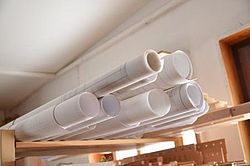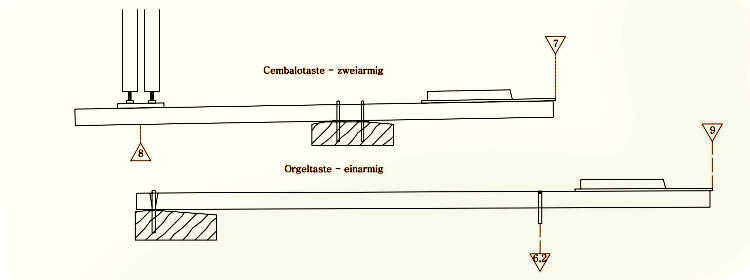2. THE CHALLENGE OF THE HARPSICHORD
Published on 25. May 2013 by Johannes Huefken
The biggest challenge consisted on the one hand in the clean execution and on the other hand in the accurate construction. The planning of the claviorganum was carried out throughout the theoretical training. After 1 1/2 years the time had come: The drawings could be printed. In the following 5 points you will get an overview of the development:
- The idea
- The concept
- The challenge
- One luck
- The Harpsichord
1. The idea
Two self-sufficient instruments can be played together via a belt if desired. The organ takes up the shape of the harpsichord's grand piano.
2. The concept
- Range: FF to f³ bass and treble separated (h°/c')
- Pitch: transposable approx. 415 / 440 / 465 Hz
- Wind pressure: approx. 60 mmWS
- belt: harpsichord on organ
Disposition
- Prinzipal 8' from h°, partly as brochure
- Bourdon 8' partly in the brochure
- Flute 4' ab h° Flute harmonique 4'
- Flute 2'
- Basson/ Hautbois 8'
The reed stop should be positioned in front of the reeds of the sound mechanics, so that it can easily be readjusted at any time.
The harpsichord is one-manual in design. It should be able to be placed on the organ both as a single instrument and easily and without the risk of damaging the coupling apparatus.
- Range: FF to f³
- Pitch: transposable approx. 415 / 440 / 465 Hz
Disposition
- principal 8'
- Nasal 8'
- flute 4'
3. The Challenge
It is impossible to construct the harpsichord first and then the organ or vice versa. Both had to grow in parallel. The harpsichord determines the shape, while the organ determines the size. The organ should not exceed 98 cm wide to fit through a 100 mm door.
Disposition, scale length, position on the chest, the distribution of the bass pipes and many technical questions such as wind supply, sound and register mechanics as well as the transposing device had to be clarified in order to determine the dimensions of the organ, which in turn gave the harpsichord its frame.
I will not go into the construction of the organ part here.
The paddock
The harpsichord should be able to be coupled to the organ. For this organ, one-armed keys in combination with pendants are ideal as hanging action. In contrast, a harpsichord always has two-armed keys, as can be seen in the following drawing.



